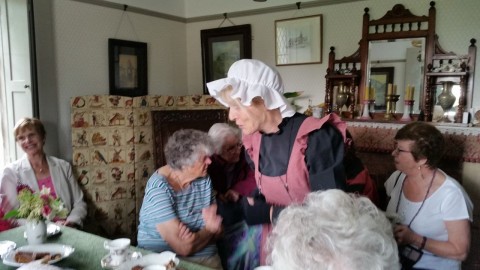
A delightful joint visit was made in May to the Sevington Victorian School, by Calne and Derry Hill and District NWR groups. We first went to Leigh Delamare church and were greeted by a lady (Dinah Starkey) in a beautiful, black Victorian costume complete with bonnet. She told us that the remains of the original derelict church were carefully removed to build the school. This work was arranged by Joseph Neeld, local land owner and philanthropist, who wished to build a school for his worker’s children and then rebuild the church in a similar style with a decorative Gothic interior. This has resulted in the School having the unusual features of a dominant bell tower, massive entrance archway and an interior wall made of a 15th century reredos. He also built cottages for his employees.
On returning to the school we were sternly greeted by Miss Elizabeth Squire, who taught at the school for 53 years. She was played by Celia Jennings who took her role very seriously and informed us we all had to pay 1d for entry, fortunately Victorian coins were provided. We were lined up for hand inspection, those with nail varnish being duly reprimanded! We entered the classroom and sat at traditional benches and desks with inkwells. Demonstrations showed us how finger stocks were used to stop boys dipping girl’s plaits into inkwells and other naughtiness, and back boards, to ensure upright posture. Class started with the issuing of slates and pencils for us to practice writing the date and a verse written on the board, a very squeaky process. We read moral verses from reading books learning such sayings as ‘If one lie is told several more will follow’. The classroom is full of material actually used by Miss Squire including a framed demonstration of how to make paper, items such as a cowrie shell and shark’s jaw , brought back by Joseph Neeld’s brother from his tropical expeditions, a chalk written attendance board and a dunces cap. The floor is also unusual being made of shaped edge-on regular logs wedged together. Finally we were somewhat intimidated by the demonstration of 3 canes!
We were then invited into Miss Squire’s parlour where a parlour maid (Sylvia Wright) helped by the other ladies, served us with tea and very tasty home-made cakes.
This was a very successful outing and we cannot give enough credit to the three ladies who reminded us of what it was like to live in Victorian times, both as children and a school teacher.
